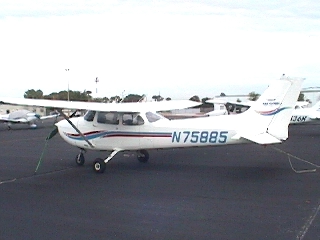Single Engine Loss of Power On Takeoff – At Night
November 18, 1990. I was regularly going back and forth to Ft. Myers for a family property project on Sanibel Island.
This night I was done for a few days and wanted to go back to Orlando to be at my own home, rather than the rental on Sanibel.
It was about 8pm as I taxied out of the Jet Center at Page Field (FMY). I was in my “favorite” C-172, N75885. This plane comes in to a lot of my adventures for some reason.
It was in the winter months so it was dark. During the run up I noticed that the left mag dropped more than usually and seemed a little rough. “Carbon on the plugs” I thought, and leaned it out at 1800 RPM for a few minutes. It seemed to smooth out.
Foreshadowing: maybe this is why I was a little more prepared than usual.
I told Tower I was ready for takeoff. I had an IFR flight plan on file, direct to KORL. (You could do that in the ’90s.)
“N75885 wind 060 at 8 kts, fly runway heading, runway 5 cleared for takeoff” came the instruction from the tower. I acknowledged and began my takeoff roll. The engine developed full power. I rotated at 55 kts and began climbing while accelerating to 75kts.
The Impossible Turn
Can You Do It?
The 180 back to the runway is a controversial move, especially at low altitude. The heavier, high powered six seaters like the Bonanza or the Saratoga would never make it. The Cessna however made it with ease, and in fact almost ran out of runway going the other way.
- Factors:
- Very low wing loading
- Low “best glide” speed
- High coefficient of lift with the Cessna wing
The “Secret” is making an IMMEDIATE steep turn back to the runway and maintaining airspeed. Previously I had not practiced this, but I do it the sim and in the aircraft if possible, on a regular basis.
At 400 feet I experienced a severe drop in RPM, to about 1700. I pitched forward to maintain 70 kts and immediately started a 45 degree left bank turn.
“885 FLY RUNWAY HEADING!” the tower screamed at me. I replied, “I’m experiencing a severe loss of power.” “Oh sorry, cleared to land any runway.” At this point the engine was sputtering badly, about 1600 rpm. I rolled out after turning more than 180 degrees, aiming back towards the airport.
Maybe it was the wind but I was high! I started a slip. Not enough. Full flaps. Still high. I knew I wasn’t supposed to do it but I yanked the engine back to idle, and did a full flaps side slip (There is a placard that says this maneuver is “not recommended.”)
I managed to get the wheels on the ground about three-quarters of the way down the runway. I applied brakes but I was still “flying” as my speed was high and the plane skipped along. Finally it settled down just as I entered the over run area at the approach end of runway 5.
I managed to stop just before the end of the runway and made a 180 to taxi back up to taxiway A.
“885 do you need assistance?” “Stand by” I said. I tried running the engine up. It got really rough above 1700 rpm.
“I’m going to taxi it in, go to my apartment, and have a mechanic look at it tomorrow in the daylight.” “Good decision” the tower replied, “Cleared to taxi to the ramp, remain with me.
Epilogue
The next day I had a mechanic take a look at the plane. “The plugs were fouled” was all he said. “I did a full power run up, leaned them out and it ran fine. You’re good to go.”
Oh was I? Like hell I was. I was not ready to take off again! “Are you sure?” I asked him. “Hey if you’re not happy, tell ground you’d like to go someplace where you can do a full power run up.”
So that’s what I did, and it ran fine. I took off and flew back to Orlando. However, if I told you I wasn’t listening to every little irregularity in the engine, well I’d be lying! Eventful 24 hours though.
